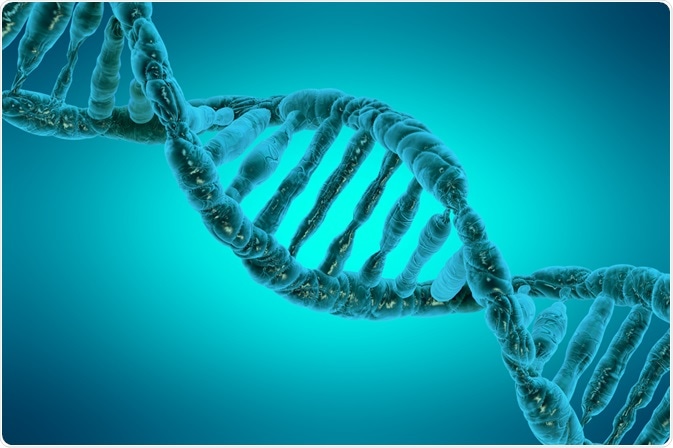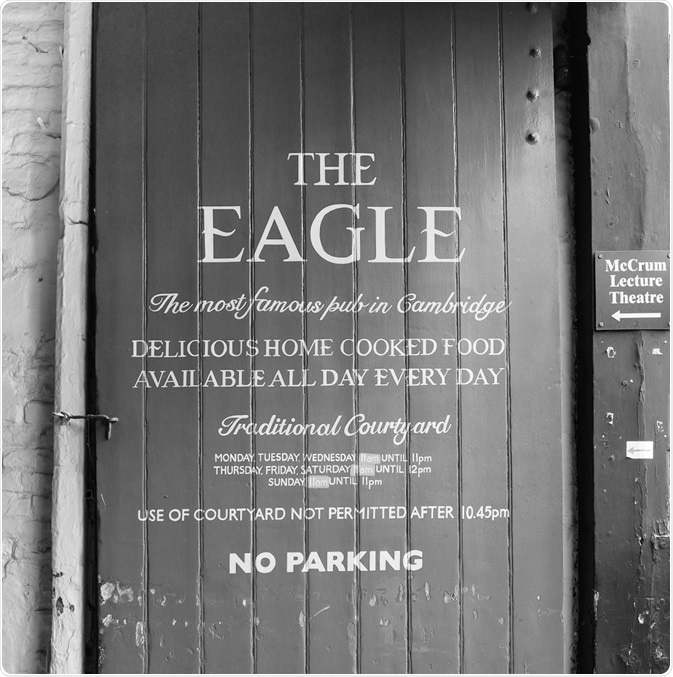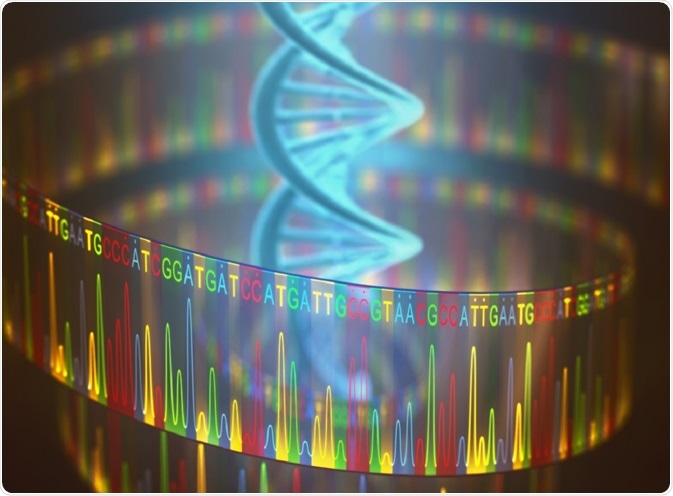The isolation of DNA was successfully carried out in 1869. However, its sequencing had to wait until the Human Genome Project was completed in 2003, more than a hundred years later.
 vitstudio | Shutterstock
vitstudio | Shutterstock
Modern genomics dates back to the 1970s, but its foundation was laid at least twenty years before this, with the creation of radioactive labels to study biomolecules. This helped scientists understand multiple bodily processes. More importantly, it helped to find the Holy Grail of genetics – the structure and sequence of the DNA double helix.
Discovering the structure of DNA
The greatest genetic discovery of the modern age is credited to Francis Crick and James Watson, who, along with Maurice Wilkins, received the 1962 Nobel Prize for Medicine for discovering the structure of DNA.
Crick was a promising English physicist who interrupted his career when the Second World War broke out to join the Admiralty. During those eight years, he switched his research field to biology, after reading the eminent physicist Erwin Schrodinger’s book, “What is Life?” and eventually joined the Cavendish Laboratory in Cambridge.
Maurice Wilkins was born in the wilderness of New Zealand to an Irish physician-researcher, but lived in the UK from the age of six. After taking his doctorate in physics, he was involved in the Manhattan Project to develop the first nuclear bomb in the USA.
Here again, Schrodinger’s book inspired him to look for the physics in genetics. After the war, he moved back to England, and joined Randall’s biophysics laboratory at King’s College, London. Here a team was eventually organized to find the structure of DNA.
This included Rosalind Franklin, an amazingly talented researcher who had joined Randall’s lab to upgrade the X-ray crystallography unit there. However, Wilkins and Franklin never did hit it off together.
James Watson was a brilliant young American scientist who first met Wilkins at a conference at Naples in 1951. The previous year, Wilkins and one of his PhD students, Raymond Gosling, had produced several X-ray images of the DNA molecule’s crystalline structure. Some of these were presented at the Naples meeting.
One image in particular proved so intriguing to James Watson that he joined Cavendish Laboratory the same year to pursue the structure of DNA. There he met 35-year-old Francis Crick, and there the lines met, for both of them agreed to work on DNA.
At the same time, Rosalind Franklin also joined the race to interpret the elusive molecule. Despite working all alone, she came astonishingly close to cracking the puzzle.
Watson and Crick worked out various theoretical aspects of DNA structure. However, to confirm its accuracy, Franklin’s clear X-ray images and her accurate measurements of various distances within the DNA unit cell proved crucial. Incorporating this data, they succeeded in publishing the double helix structure of DNA in 1953, as well as showing its replication capability. Despite the key role played by Franklin’s work, she was omitted from the Nobel Prize citation.
Francis Crick went on to study protein manufacture and genetic regulation of this process. He also put forward the ‘sequence hypothesis’ - that it was the sequence of bases in the DNA molecule that encoded genetic information (the order of amino acids built up into each protein).
Crick teamed up with George Gamow, another physicist-biologist, to publish their famous ‘triplet theory’ in 1958. This hypothesis, now known as the ‘central dogma of molecular biology’, states that the DNA code is transcribed into RNA which is decoded by means of codons. Codons are sets of three bases which specify different amino acids. The order of these triplets decides the specific order of amino acids which will form the given protein.
 The Eagle Pub where Crick and Watson announced they had discovered the structure of DNA in 1953. (Image taken by Claudio Divizia, 2018 - Shutterstock).
The Eagle Pub where Crick and Watson announced they had discovered the structure of DNA in 1953. (Image taken by Claudio Divizia, 2018 - Shutterstock).
What is Sanger sequencing?
Following the discovery of DNA, new technology rapidly emerged, that allowed rapid automated determination of the nucleotide sequences in DNA fragments. The polymerase chain reaction was invented, allowing enormous amplification of a minute amount of DNA containing a gene of interest. Later innovations made this method cost-effective and 'fuss-free'.
Recombinant DNA technology was developed in 1973, and allowed the characterization and manipulation of large genomes. 1977 saw the first gene being isolated.
The honor of sequencing a genome for the first time goes to Fred Sanger, giant among British scientists, and double Nobel laureate. He sequenced both a viral and a mitochondrial genome completely, making him the first genomics scientist.
After working on the sequencing of DNA for 15 patient years at the Medical Research Council (MRC) Laboratory in Molecular Biology, he published the earliest technology to determine the order of bases in a DNA molecule - the ‘Sanger sequencing method’.
Sanger sequencing kicked off an epoch in DNA sequencing, and shaped the science of genomics. It also earned him his second Nobel Prize. Today the method has advanced to allow the reading of up to 800 bases simultaneously.
 ktsdesign | Shutterstock
ktsdesign | Shutterstock
The Human Genome Project
The breakthroughs in DNA structure, decoding and sequencing were crucial to the establishment of the Human Genome Project. From 1993 to 2003, it brought together top-notch scientists from 20 institutions across six countries to successfully unravel the sequence of the three billion nitrogenous bases in a human DNA molecule.
Why is genome mapping important? The answer is that it puts together bits of the whole genome to help researchers find their way around it and locate genes of interest.
Enter John Sulston, a vicar’s son, who had always been curious about ‘how organisms work’. Eventually becoming a molecular biologist, he joined the MRC Laboratory, Cambridge.
John Sulston and the worm
South African Sydney Brenner was working on mutations which caused changes in the way the worm moved, because he wanted to know how genes regulated life processes at molecular level. Sulston collaborated with him at MRC but space and funds were short. Sulston then successfully lobbied the Wellcome Trust and Medical Research Council to set up a new laboratory devoted to genomic studies. This was the start of the Wellcome Sanger Center, of which he became the founder-director in 1992, remaining until 2000.
In 1998, after 12 years of patient work, Sulston’s team, working with Robert Waterston’s team in St. Louis, USA, published the first ever complete animal DNA sequence, of the nematode Caenorhabditis elegans (C. elegans), used as a prototype for other species. For this, he shared the Nobel Prize along with fellow researchers Sydney Brenner and Robert Horwitz.
While this project had initially been intended to follow up on the connection between the development of C. elegans and its genetics, it was so successful that it rapidly became a prototype for the Human Genome Project, for which this became the UK center.
Its success was a crucial proof-of-concept for the cost-effective high-throughput methods used to uncover the human DNA sequence, as well as to show their limitations and advantages. By the end of his tenure, using the Sanger sequencing methods, the first draft of the sequence of the human genome was complete.
John Sulston’s passion was not just making scientific discoveries, he also insisted on making all his scientific research freely available to anyone. This, he felt, was the only way to speed up progress within the community. This has remained central to the Wellcome Sanger Institute ethos to this day.
Mike Stratton and cancer genes
Simultaneously, Mike Stratton began to set up the Cancer Genome Project at the Institute, attempting to map all the cancer-causing genes in the human genome. He had already identified the BRCA2 gene, one of the two genes that cause most breast cancers in women, and the BRAF gene involved in six out of ten malignant melanomas. He also helped discover other genes implicated in breast, testicular, colorectal and thyroid cancer.
The next step forward could have happened only after full-genome sequencing succeeded, because it focused on mapping the functional genome, which consists only of functional genes. This led to the focused study of gene regions within the DNA molecule in order to relate the physical structure to their outer expression in the body and its working.
Allan Bradley worked throughout his student life at Cambridge, following which he took up the production of knockout mice using embryonic stem cells. These are mice which lack certain specific genes. He followed this up with work on gene targeting and genetic manipulation techniques, which were useful in many laboratory genetic technologies and processes.
At this point he was engaged in making his work commercially viable by offering it for sale. When he later became the new director of the Sanger Institute in 2000, he transformed it into a center which focused on obtaining biological information from the sequenced genome.
Some examples include the International Cancer Genome Consortium which focused on the cancer genome, and the 100 000 Genomes Project to sequence genomes from both normal and affected cells in patients with cancer, for instance, and those with a rare disease..
Next-generation sequencing emerged in 2007 and proved to be another transformative step, enabling millions of DNA samples to be sequenced together using massive parallel sequencing (MPS). This makes sample preparation faster, it is extremely customizable, and has brought down the cost enormously. It is actually possible to sequence one human genome for less than £ 700 in a single day, compared to the £ 2 billion and 10 years it took for the first one!
Almost immediately this has been followed by third-generation sequencing. This technology makes use of bases labeled with fluorescent tags and DNA polymerase enzyme technology. This produces DNA fragments 10-15 thousand bases long, making genomic sequencing much simpler and eliminating the need to join fragments in the case of smaller genomes. This has enabled the ‘revision’ of already sequenced genomes to virtually 100% accuracy, and eventually scientists hope to sequence the entire human genome within just one hour!
All this has occurred within just two years of the Human Genome Project. Doubtless, many more discoveries are to be made which will facilitate personalized diagnosis and treatment based on genomic variations in a host of disease conditions.
Further Reading